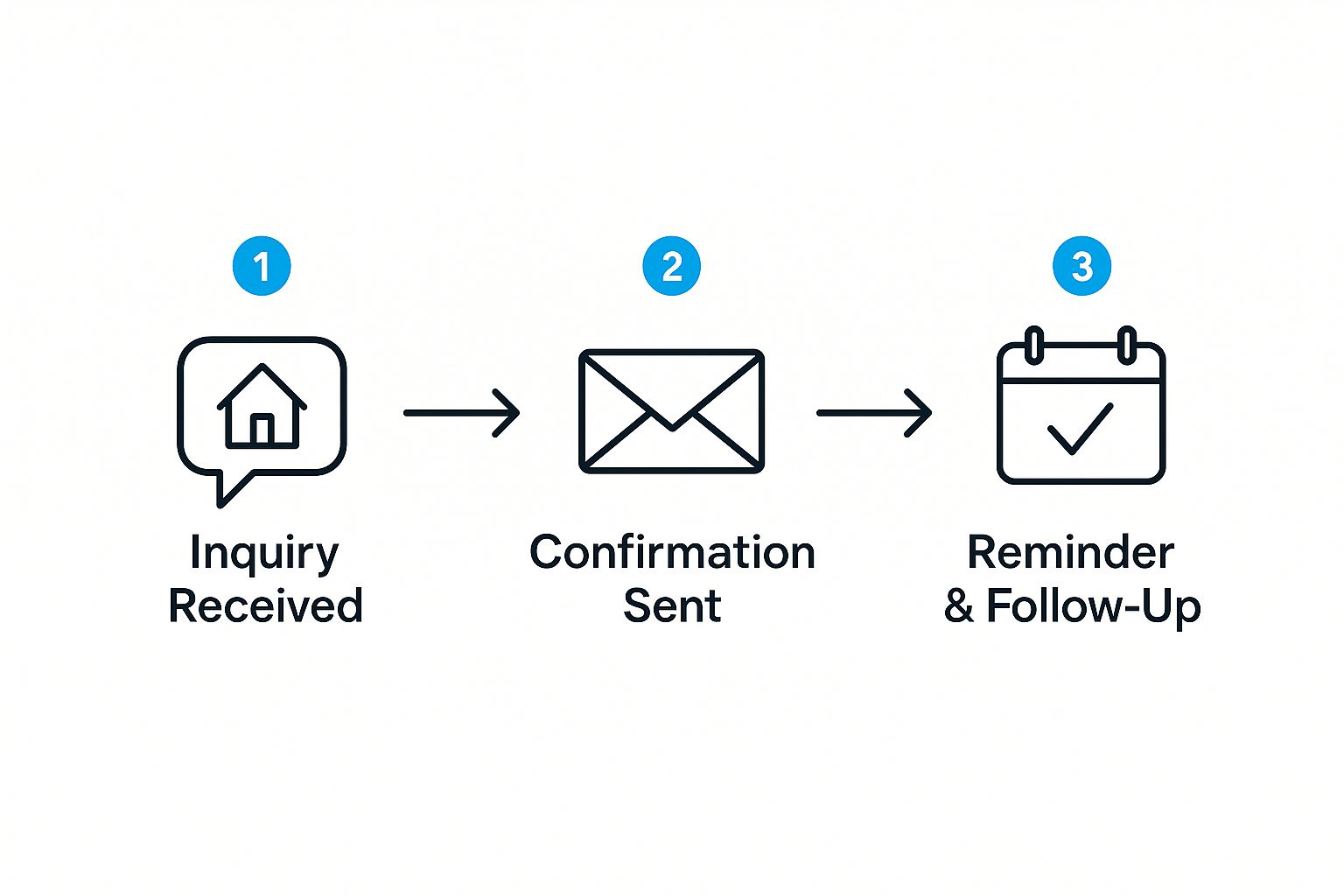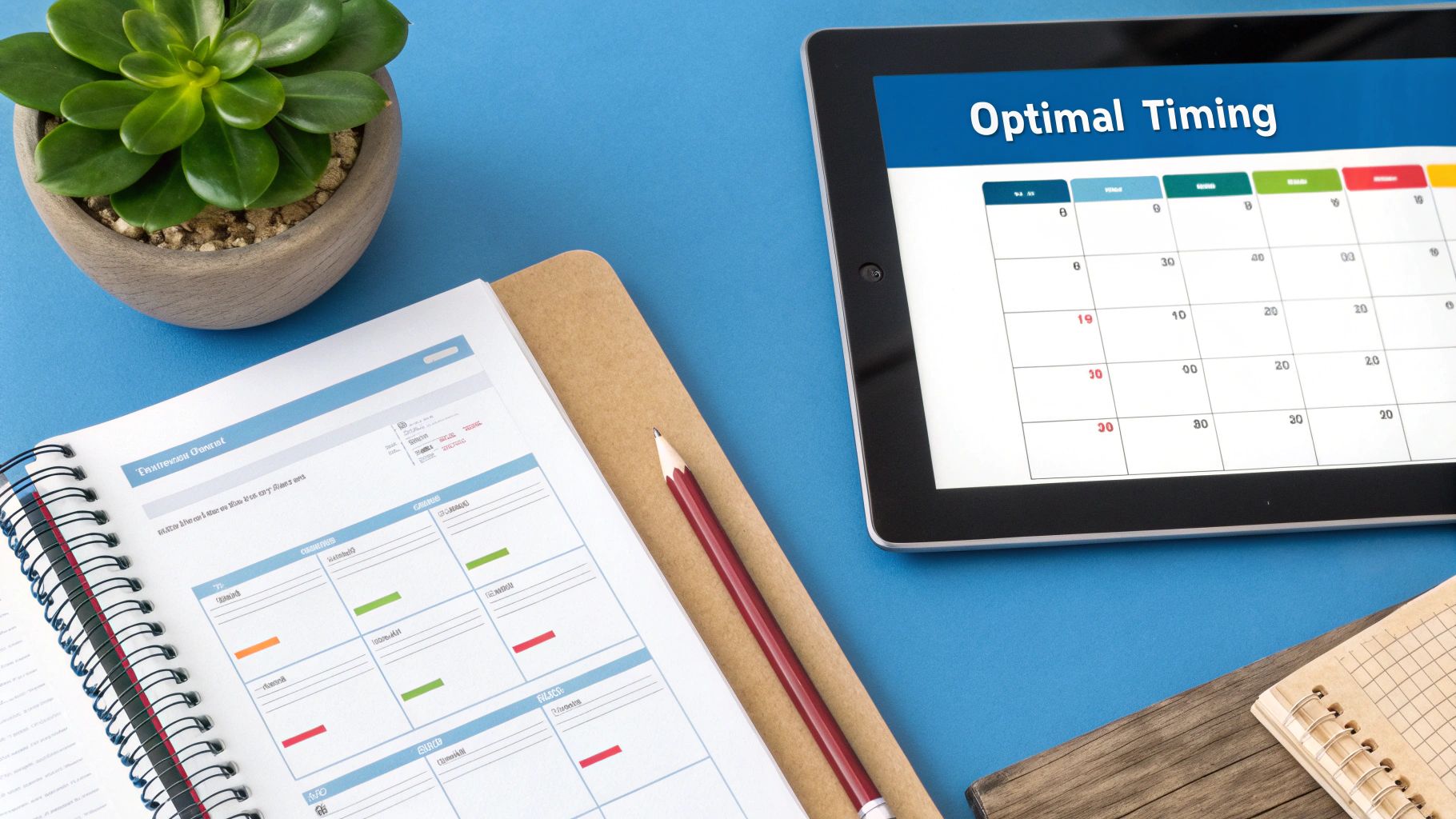When you're managing a massive portfolio of 1,000 to 10,000+ units, scheduling showings isn't just another task on the to-do list—it's a core driver of your revenue and a critical factor in your cost-per-door metrics. A clunky, inefficient process creates friction that slows down the entire leasing funnel. Every hour a qualified lead waits for a showing confirmation is another hour they might be touring a competitor's property. That delay directly inflates your Days on Market (DOM) and eats away at your bottom line.
Why Inefficient Scheduling Is Costing Your Portfolio
At scale, the financial hit from a slow, manual scheduling process is staggering. If you’re managing hundreds or thousands of scattered single-family rentals (SFRs) or multifamily units without dedicated onsite staff, the logistics just multiply. Trying to coordinate agent availability, prospect schedules, and property access across a distributed portfolio quickly turns into a massive operational bottleneck.
This friction doesn't just frustrate potential tenants; it actively costs you money.

The True Cost of a Vacant Day
Let's break down the direct revenue loss. For a portfolio of 1,000 units with an average monthly rent of $2,000, the daily revenue is roughly $66,667. That means every single day of vacancy across your portfolio costs you that much in potential income. Slow lead response and delayed tours can easily tack on an extra 5-7 days to your average DOM.
For a 1,000-unit portfolio, reducing DOM by just one week could recover over $460,000 in annual revenue. This transforms scheduling from a simple administrative task into one of the highest-impact levers for financial performance.
This kind of delay creates a ripple effect, hurting the key performance indicators (KPIs) that matter most to enterprise-level operators:
- Decreased Lead-to-Tour Conversion: Hot leads have a short shelf life. Research shows that responding to a lead within five minutes dramatically increases the odds of conversion. Manual scheduling makes that kind of speed-to-lease almost impossible to maintain consistently across thousands of units.
- Inflated Cost Per Door: Wasted agent time, the administrative drag of back-and-forth emails, and missed opportunities all drive up the operational cost for every single unit you manage.
- Inconsistent Brand Experience: A clunky, slow scheduling process is often the very first interaction a prospect has with your brand. It creates a negative impression before they even set foot on a property, undermining the professional image of your large-scale operation.
Ultimately, inefficient scheduling is a silent killer of portfolio performance. By reframing smart, automated scheduling as an essential solution, large-scale property managers can turn this major cost center into a powerful competitive advantage, directly impacting speed-to-lease and maximizing revenue.
Building a Scheduling System That Scales With You
Growing from 500 units to 5,000 isn't just about hiring more people. If you just throw more bodies at the problem, you’ll end up with tangled communication lines, bloated payroll, and the same old inefficiencies, just on a much larger scale.
To truly scale, you have to ditch the spreadsheets, the endless phone tag, and the manual calendar invites. Your entire showing process needs a rock-solid, automated framework designed for a distributed portfolio.
The Central Showing Calendar: Your Single Source of Truth
The heart of any scalable showing system is a central calendar. And no, that doesn't just mean a shared Google Calendar. This is a dynamic, intelligent hub that acts as the single source of truth for your entire leasing team.
For this to work, it absolutely must integrate directly with your Property Management Software (PMS) through a solid API connection. Why is this non-negotiable? Because it means the moment a unit's status flips from "occupied" to "available" in your PMS, your scheduling calendar knows. Instantly. This simple connection eliminates the nightmare scenario of showing an already-leased unit or double-booking an agent.
Automating How You Capture and Qualify Leads
Next, you need to automate how you handle incoming leads. A smart scheduling platform will pull inquiries from all the major listing sites—Zillow, Apartments.com, your own website—and drop them into one clean dashboard. No more bouncing between a dozen different inboxes.
But just catching the leads isn't enough. When you're dealing with hundreds or thousands of inquiries, your team can't afford to waste time on every single one. This is where smart routing and pre-qualification become your best friends. The system should automatically filter prospects based on your specific criteria, like their desired move-in date or income level, before they can even book a tour.
Think about how that streamlines the whole front-end of your leasing process.

As you can see, a systemized approach means every single lead gets an immediate, professional response. This alone can dramatically improve your lead-to-tour conversion rates.
Creating a Seamless Data Ecosystem
Finally, everything needs to talk to each other. Modern real estate scheduling platforms are built to be the central nervous system of your leasing operation. Through API integrations, data flows seamlessly between your lead sources, your calendar, your PMS, and even your agent assignment tools.
This constant, automatic sync ensures that property availability, pricing, and prospect info are always accurate across your entire tech stack. That means no more manual data entry and no more costly communication breakdowns between team members.
By building a single, integrated system, you get rid of the operational drag that quietly inflates your cost per door. This frees up your team to focus on what they do best: nurturing qualified leads and closing leases.
This is exactly how you build a leasing machine that doesn't just manage growth but actually fuels it. When every step, from the first inquiry to the confirmed showing, is automated and synchronized, you can deliver a consistent, top-notch experience whether you have 100 units or 10,000.
You can see how all these pieces fit together by exploring modern leasing and showing software. It’s this kind of systemization that ultimately slashes your days on market and boosts your portfolio's bottom line.
Optimizing Agent Assignments and Tour Routes
Once you've captured and qualified a lead, the clock starts ticking. The next big hurdle is getting the right agent to the right property, and doing it fast. If you're managing a large portfolio, assigning agents by hand is a surefire way to watch your Days on Market (DOM) climb and leave revenue on the table. A smart real estate scheduling system can turn this classic bottleneck into a smooth, automated workflow.

It all starts with automated agent dispatching. Forget having a leasing manager manually cross-referencing calendars and property locations. The right system uses rule-based logic to make the best assignment instantly. This isn't just about finding who's free; it's about finding who's best for that specific showing.
Implementing Rule-Based Dispatching
Truly effective dispatching logic pulls in multiple variables to drive efficiency across your entire portfolio. You can customize these rules to match your company's priorities, creating a completely hands-off assignment process.
Think about setting rules based on criteria like:
- Geographic Zoning: You can assign agents to specific territories or neighborhoods. This keeps them from crisscrossing the city all day, drastically cutting down on wasted travel time and letting them fit more tours into their schedule.
- Agent Availability: The system should sync with your agents' calendars in real-time. That way, assignments only go to people who are actually available, eliminating all the back-and-forth phone calls and texts that slow everything down.
- Performance Metrics: Why not send your best closers to your most qualified prospects? You can set rules to prioritize agents who have higher lead-to-lease conversion rates, putting your A-team on your hottest leads.
Intelligent Tour Route Optimization
Getting the individual assignment right is one thing, but the real magic happens when you start optimizing tour routes at scale. Let's say you get three tour requests for properties all in the same part of town. Manually, you might end up sending three different agents, which means triple the mileage and triple the cost.
An intelligent platform is smart enough to bundle those showings. It sees the geographically clustered requests and assigns them to a single agent as one efficient trip. This kind of operational tweak has a direct, positive impact on your cost per door.
By bundling showings and optimizing routes, property managers can see a huge jump in agent utilization rates. You’re essentially handling more tours with the exact same number of staff, which directly boosts operational efficiency and lowers your overall leasing expenses.
Leveraging On-Demand Agent Networks
So, what do you do when it's peak leasing season and your team is slammed? Or what about those properties in remote markets where you don't have boots on the ground? This is where an on-demand agent network becomes a total game-changer. These networks give you access to a vetted pool of licensed real estate agents who can be dispatched whenever you need them, ensuring you never have to turn down a showing.
This flexible model is a must for capturing those high-intent leads who request same-day tours. Being able to say "yes" to an immediate tour request is often the very thing that converts a prospect before they move on to the next listing. It gives large, distributed portfolios the scalability and geographic reach needed to keep DOM low and occupancy high, no matter the market.
How Market Trends Should Shape Your Scheduling Strategy
Your scheduling tactics don't exist in a bubble. They’re directly tied to bigger market forces, from what's happening in the financial markets to the new construction pipeline in your city. For property management companies with large portfolios, connecting your day-to-day scheduling to these macro trends is what separates the good from the great. It’s how you set realistic KPIs and justify investing in the right tech.

Think about the availability of capital. When financing is easy to come by, the build-to-rent sector can explode, flooding the market with new inventory that needs to be leased up fast. In that kind of environment, you need a real estate scheduling system that’s hyper-efficient and can handle a massive volume of inquiries, turning them into tours almost instantly.
Adapting to Shifting Capital Markets
On the flip side, when capital markets tighten up, renters take longer to make decisions and new development slows to a crawl. Your strategy has to shift. Persistence is suddenly the name of the game. Your system needs robust, automated follow-up sequences that can nurture leads over a longer period without completely burning out your team.
These financial conditions are becoming more and more influential. A recent Deloitte survey found that 68% of commercial real estate professionals were optimistic about market fundamentals and easier financing. That kind of sentiment points directly to higher leasing velocity, which makes having a seamless scheduling process more urgent than ever.
When the market is hot, the speed of your leasing cycle becomes your biggest competitive advantage. The ability to get a prospect into a unit for a same-day or next-day tour can be the one thing that gets a lease signed before they even look anywhere else. That has a direct impact on your Days on Market (DOM).
Understanding these dynamics helps you draw a straight line from your scheduling technology to real financial outcomes. It’s not just about booking tours; it’s about strategically reacting to market signals to keep occupancy high and revenue flowing. If you want to dig deeper into this, we have a detailed guide on how showing availability impacts vacancy rate.
By syncing your scheduling strategy with real-time market trends, you can be proactive, set achievable goals for your team, and build an undeniable business case for investing in automation. It’s what helps you thrive, no matter what the economy throws at you.
Manual vs Automated Scheduling ROI for a 1000 Unit Portfolio
The numbers don't lie. For a portfolio of this size, making the switch isn't just an operational improvement—it's a massive revenue driver that adds nearly $865,000 back to the bottom line each year.
Measuring the KPIs That Actually Matter
If you can't measure it, you can't improve it. For enterprise property managers, this isn't just some business cliché—it's the core principle separating profitable portfolios from stagnant ones. A smart real estate scheduling system can spit out a ton of data, but success comes from tracking the key performance indicators (KPIs) that directly grow your revenue, not just the ones that look good on a chart.
It’s time to move beyond simple tour counts. The real story of your leasing funnel is told through the metrics that measure speed, efficiency, and conversion. These are the numbers that should live on your operations dashboard, giving you a real-time pulse on the health of your entire leasing pipeline.
Core KPIs for Enterprise Leasing Operations
To really optimize your scheduling at scale, you need to zero in on a handful of high-impact metrics. These KPIs draw a straight line from that first lead inquiry all the way to a signed lease.
Lead-to-Tour Conversion Rate: This is arguably the most critical metric at the top of your funnel. It tells you what percentage of qualified leads actually book a showing. If this number is low, it’s a huge red flag for friction in your scheduling process—things like limited tour availability or slow follow-up. Industry leaders are shooting for a conversion rate of 40% or higher for truly qualified leads.
Average Time-to-Showing: How long does it take from the moment a prospect says "I'm interested" to the moment they’re standing inside the property? Every single hour matters here. When you can shrink this time from days down to just hours by offering same-day or next-day tours, you dramatically boost your chances of signing a lease before that prospect even sees a competitor’s unit.
Agent Utilization Rate: This metric tracks how efficiently your showing agents are spending their time. Are they spending more time driving between properties than actually showing them? A low utilization rate points directly to sloppy tour routing and dispatching, which inflates your cost-per-door and quickly burns out your team.
For large portfolios, even tiny improvements in these core KPIs can create massive financial returns. A 5% bump in your lead-to-tour conversion rate across a 2,000-unit portfolio can easily translate into hundreds of thousands of dollars in extra annual revenue, simply by filling your vacancies faster.
Connecting KPIs to Financial Performance
The ultimate goal of tracking these metrics is to build a rock-solid business case for your technology investments. When you can connect KPI improvements directly to financial outcomes, you can calculate the true ROI of your scheduling automation. The logic is simple, but powerful.
For instance, if you cut your average time-to-showing by 48 hours, you can draw a direct line from that improvement to a reduction in your Days on Market (DOM). That’s a clear financial win that resonates with owners and stakeholders.
This data-driven approach shifts the conversation around scheduling from a cost center to a strategic revenue driver. You can learn more about how it all connects by exploring these seven proven ways to lease properties quicker and cheaper. By consistently measuring what truly matters, you can build a leasing operation that’s more efficient, scalable, and ultimately, more profitable.
Have Questions About Automation? You're Not Alone.
Whenever you bring a new piece of tech into your operations, especially for something as core as scheduling, questions are going to come up. For operations directors overseeing large portfolios, you need to know exactly how it all fits together—the integrations, the financial upside, and the quality control. Nailing these details is what separates a clunky rollout from a game-changing investment.
One of the first things people ask is how a new tool will play with their existing systems. It's a great question, because the last thing anyone needs is another siloed piece of software creating more work.
How Does This Actually Integrate With My PMS?
The best platforms are built with an API-first approach, meaning they’re designed to connect seamlessly with major Property Management Software (PMS) like AppFolio or Yardi. This isn't just a one-way data dump; it's a constant, two-way sync that keeps everything in lockstep.
Property data—think unit availability, rent prices, and listing details—gets pulled from your PMS in real-time. As tours happen, all that valuable information—prospect feedback, agent notes, tour outcomes—is pushed right back into the prospect’s record in your PMS. This completely eliminates double entry and ensures your entire team is working from a single source of truth. For a large portfolio, that kind of data integrity is non-negotiable.
What’s the Real Financial Impact Here?
When you boil it down, the single biggest financial win comes from slashing your Days on Market (DOM). Every single day a unit sits empty, it's a direct hit to your bottom line. That's real, tangible revenue walking out the door.
By opening the door to same-day tours and converting leads the moment they show interest, a well-oiled scheduling system can easily shave 5-10 days off your average DOM for every single turnover.
Let’s put some numbers on that. For a 1,000-unit portfolio with an average rent of $2,000 a month, cutting your DOM by just one week puts over $460,000 back into your annual revenue. Suddenly, scheduling automation isn't just an expense—it's one of the highest-ROI moves you can make.
Your speed-to-lease becomes your most powerful financial lever.
How Do You Guarantee Quality and Security With On-Demand Agents?
I get it. Handing showings over to a third-party network can feel like you're losing control. But modern platforms are actually built to give you more oversight, not less. It’s all about a multi-layered system that keeps quality high and properties secure, even at scale.
It all starts with a seriously tough vetting process. Every on-demand agent goes through background checks and license verification before they ever set foot on a property. After each and every tour, they submit standardized digital reports. This creates an incredibly powerful quality control loop, giving you consistent, structured feedback from every showing.
Then, technology steps in to provide an extra layer of robust oversight with features like:
- Geo-fencing to confirm an agent was physically at the property when they said they were.
- Time-stamped logs that create a clear, un-editable record of all activity.
- Secure lockbox integrations to manage and monitor property access safely.
What you end up with is a complete digital audit trail. This gives you far more visibility and control than you could ever hope to achieve with old-school, manual methods. It’s a system designed for trust and accountability, perfect for managing a distributed portfolio.
Ready to see how much you can shrink your Days on Market and boost your lead-to-tour conversion rate? Showdigs provides the enterprise-grade scheduling automation and on-demand agent network built for large-scale property managers operating distributed portfolios.







